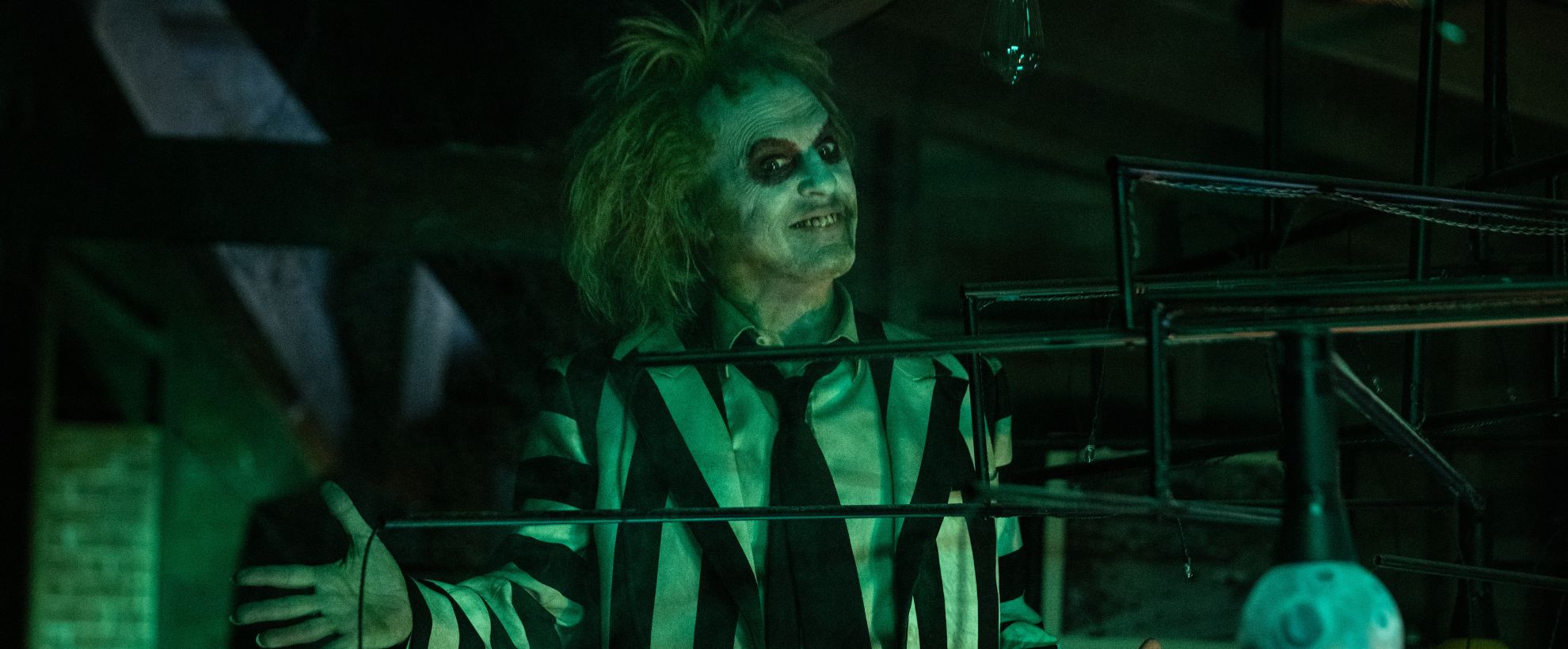
Beetlejuice Beetlejuice
Beetlejuice est de retour ! Après une tragédie familiale inattendue, trois générations de la famille Deetz retournent chez elles à Winter River. Toujours hantée par Beetlejuice, la vie de Lydia est bouleversée lorsque sa fille adolescente rebelle, Astrid, découvre la mystérieuse maquette de la ville dans le grenier et que le portail vers l'au-delà est accidentellement ouvert. Les problèmes se multipliant dans les deux royaumes, ce n'est qu'une question de temps avant que quelqu'un ne prononce trois fois le nom de Beetlejuice et que l'espiègle démon ne revienne pour semer la pagaille à sa manière.
Dirigées par le superviseur des effets visuels Mat Krentz, les équipes de Framestore ont été ravies de contribuer à la suite du film de Tim Burton, en apportant leur expertise pour créer le style visuel distinct et emblématique du film.
Beetlejuice Beetlejuice est sorti en salles le 6 septembre 2024.
Comme toujours, travailler avec l'équipe de Framestore a été un plaisir du début à la fin. Mat Krentz et Dan Booty ont dirigé une magnifique équipe à Vancouver en veillant à ce que la qualité soit irréprochable. Ils ont fait preuve d'une grande créativité et leur enthousiasme n'a jamais faibli. Ils ont également apporté la tranquillité d'esprit, car vous pouviez être sûr que leur travail ne serait rien de moins qu'exemplaire. Naviguer ensemble dans l'au-delà a été une joie. Je ferais appel à eux à tout moment. Framestore Framestore Framestore Framestore !
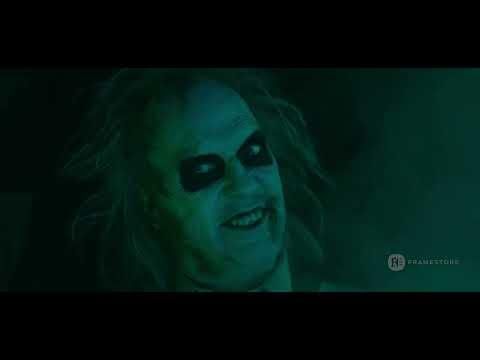
Beetlejuice Beetlejuice | Showreel | Framestore
L'effrayant bébé Beetlejuice
Les prothèses et les modèles de Baby Beetlejuice ont été créés par le département artistique de la production. L'équipe de Framestore a été chargée d'augmenter numériquement leur travail afin d'assurer une intégration transparente dans les scènes finales. La majeure partie du travail a consisté à remplacer numériquement les mains et les pieds de la marionnette afin d'améliorer l'articulation et les mouvements effrayants du personnage. Pour ce faire, il a fallu développer un système de suivi robuste, peindre méticuleusement les marionnettistes et, le cas échéant, compléter le costume pratique par des images de synthèse afin d'obtenir un résultat final homogène.
L'équipe a également renforcé le caractère effrayant de Baby Beetlejuice en ajoutant des détails subtils - et souvent grossiers - tels que l'humidité de ses yeux, la salive et les mouches en images de synthèse qui bourdonnent autour du visage crasseux du personnage. Les augmentations de costumes ont également contribué à l'effet général.
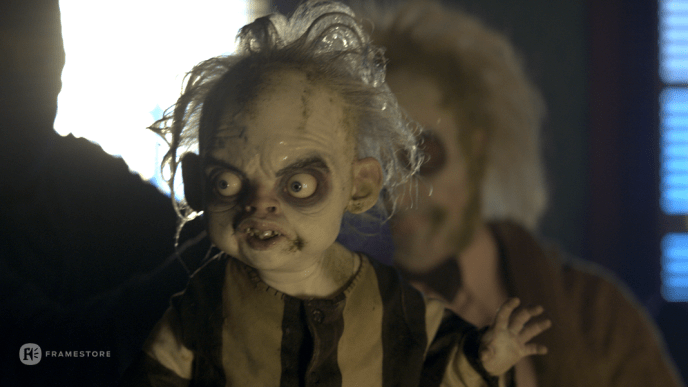
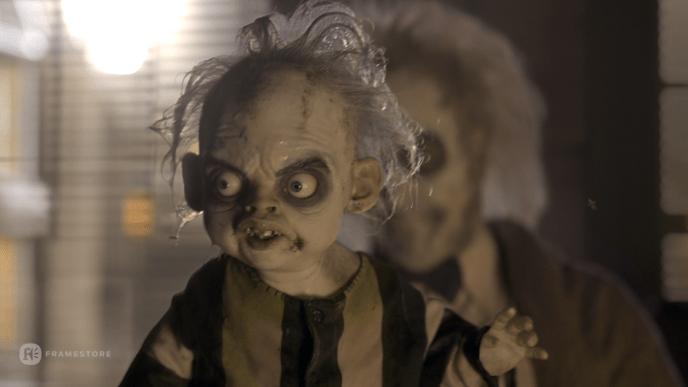
La plupart de nos efforts sont consacrés à la création d'effets visuels de soutien, qui améliorent principalement ce que les marionnettes ne peuvent pas réaliser par elles-mêmes. Il ne s'agit pas seulement d'assurer la précision visuelle, mais aussi de renforcer la capacité des marionnettes à exprimer des émotions et des actions de manière convaincante.
Delores démembrée
Delores, interprétée par Monica Bellucci, est un démon suceur d'âme qui a l'intention de hanter Beetlejuice, son ancien soupirant. Lors de sa première apparition, les parties de son corps sortent de différentes boîtes, se rassemblent et sont agrafées pour la reconstituer. L'équipe de Framestore a créé chaque élément du corps et a géré le processus d'assemblage tout au long de la séquence.

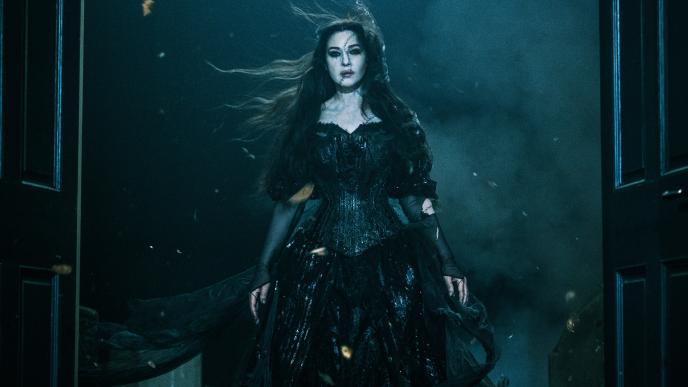
L'objectif était de créer un effet équilibré, sans être trop sanglant ou gore, en accord avec le ton décalé du film. Pour obtenir cet effet à la fois macabre et comique, l'équipe a utilisé comme référence de la viande sèche et vieillie. Mat Krentz était sur le plateau pour le tournage de la séquence, coordonnant avec plusieurs marionnettistes le placement et la combinaison appropriés des parties du corps et des couches nécessaires à l'équipe VFX pour assembler la séquence finale.
« Le mélange d'effets pratiques et numériques dans cette scène a été un véritable défi », explique Krentz. « Nous avons dû suivre le corps de chaque acteur et rendre les membres en CG avec des 'meatcaps' pour qu'ils se fondent dans la séquence en prise de vue réelle. Certaines parties, comme le torse, ont été entièrement remplacées par des images de synthèse, ce qui a nécessité des simulations de tissu détaillées pour obtenir des mouvements réalistes. Nos équipes de graphistes et de peintres ont réalisé un travail remarquable en préparant les images de synthèse et en nettoyant les parties du cadre où ces pièces devaient être placées. Hitesh Solanki, superviseur de l'image de synthèse, a joué un rôle clé dans la gestion des complexités, en veillant à ce que les éléments numériques s'intègrent parfaitement aux effets pratiques, en maintenant le ton surréaliste et comique de la scène.
Cavité de la morsure de requin
Dans cette suite, Charles Deetz se trouve dans l'au-delà - après avoir été mordu par un requin qui n'a laissé que la moitié de son corps derrière lui, ce qui provoque des giclées de sang chaque fois qu'il parle. Framestore a remplacé la moitié supérieure du corps par une cavité de morsure de requin en images de synthèse, complétant ainsi la conception du costume tout en ajoutant le contrôle de l'animation pour l'œsophage qui devait produire les effets de giclées de sang. « Nous avons eu beaucoup de plaisir à collaborer sur le timing comique des dialogues et des giclées, en particulier pour décider de la quantité de sang à utiliser sans tomber dans l'excès », déclare Krentz.
La maquette
La maquette dans le grenier est un autre exemple de la manière dont l'équipe a réalisé un travail transparent et invisible en créant des extensions partielles du décor en images de synthèse et en reproduisant des parties de la ville miniature, en les mélangeant parfaitement avec les décors artisanaux tournés sur place. « Tout devait ressembler à ce qui aurait pu être filmé à la caméra », explique Krentz. « Cela signifie qu'il devait être aussi imparfait et bancal que les décors environnants. Il n'y avait pas une seule arête droite, et l'intégration de notre travail a été un véritable défi !
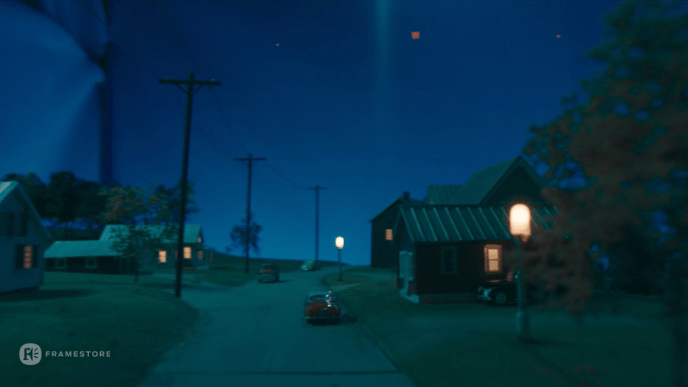
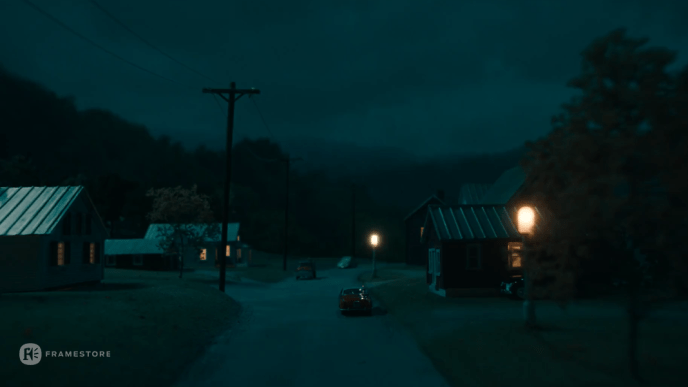

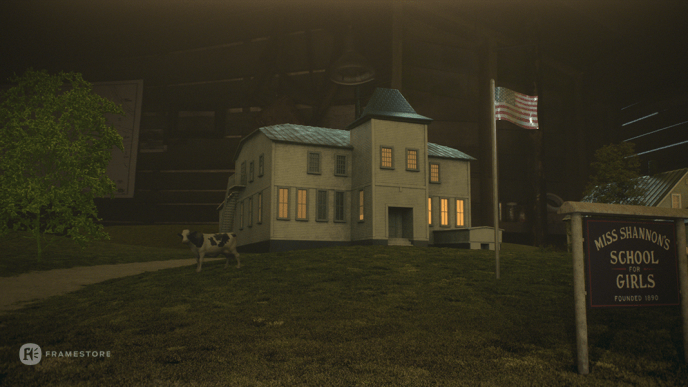
Nous sommes là pour faciliter la vision du réalisateur et étendre ce qui est possible sur le plateau. Notre objectif est de rendre les éléments en images de synthèse indétectables. Tim Burton préfère les effets qui ne crient pas à l'image de synthèse ; ils doivent avoir l'air organiques, presque comme s'ils n'étaient pas là.

